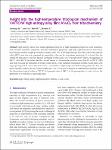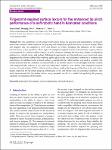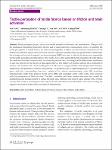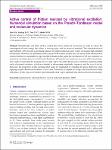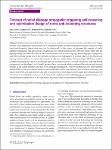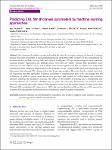Search
Author
- Agnese, Spadi (1)
- Alessandro A., Quarta (1)
- Alexander, Buchholz (1)
- Andrés, Guzmán (1)
- next >
Subject
- (BTA-P4444-Lig (1)
- (PVPA)-modified Ti6Al4V (1)
- 2D Reynolds equation (1)
- A-g-CNPs and C-g-CNPs (1)
- next >
Has File(s)
- true (43)
Search Results
High-entropy alloys have made significant progress in high mechanical properties, wear resistance, and corrosion resistance properties. Excellent tribological properties, especially high-temperature lubrication, have become another sought performance. In this work, VAlTiCrW high-entropy alloy film with body-centered cubic (BCC) structure was prepared on superalloy substrate by magnetron sputtering. It is found that the VAlTiCrW film shows very low friction coefficient of 0.15 and a low wear rate of 10−5 orders of magnitude at 800 °C. After 800 °C oxidation, the film can still obtain a friction coefficient of no more than 0.2 at 700 °C. XRD and TEM revealed the formation of ternary oxide AlV3O9 with preferred orientation of (002) crystal plane with large spacing of 0.71 nm on the wea... |
Polyalkylene glycol (PAG) aqueous solutions have recently been demonstrated to exhibit an ultralow friction coefficient (COF, μ < 0.01). However, the prolonged running-in period and low bearing capacity have limited its widespread application. In this study, we determined that the running-in period can be decreased by more than 75% when the pH value of the lubricant is controlled at 3 by introducing various acid solutions. Additionally, less time was required to realize stable superlubricity with inorganic acid at lower pH values. This was mainly attributed to the acceleration effect of hydrogen ions around the contact region. In case of PAG aqueous solution with organic acid, the wear loss between sliding solid surfaces was reduced, and thus the bearing pressure during the superlub... |
The core capabilities of soft grippers/soft robotic hands are grasping and manipulation. At present, most related research often improves the grasping and manipulation performance by structural design. When soft grippers rely on compressive force and friction to achieve grasping, the influence of the surface microstructure is also significant. Three types of fingerprint-inspired textures with relatively regular patterns were prepared on a silicone rubber surface via mold casting by imitating the three basic shapes of fingerprint patterns (i.e., whorls, loops, and arches). Tribological experiments and tip pinch tests were performed using fingerprint-like silicone rubber films rubbing against glass in dry and lubricated conditions to examine their performance. |
Tactile perception plays a critical role in the interaction of humans and environment. It begins with the mechanical stimulation induced by friction and is processed in the somatosensory cortex. To quantify the tactile perceptions of textile fabrics, the mechanical properties of fabrics and the features extracted from the friction and vibration signals were correlated with the subjective sensation rated by questionnaires. Meanwhile, the technique of functional magnetic resonance imaging (fMRI) was used to identify the brain areas responsible for the tactile perception of textile fabrics. |
Herein, a porous oil-containing material with hierarchical pore structure was successfully prepared through microtexturing large pores on the surface of porous polyimide (PPI) with single-level small pores. Compared to the conventional oil-containing material, the hierarchically porous oil-containing material exhibited high oil-content, and retained excellent mechanical properties and high oil-retention because of the synergistic effects of large pores and small pores. Furthermore, the lubricant stored in the hierarchically porous polyimide could release to the interface under thermal-and-mechano-stimuli, and the released lubricant could be reabsorbed into the hierarchically porous polyimide via the capillary-force offered by the porous channel. Based on the high oil-content and rec... |
Superlubricity and active friction control have been extensively researched in order to reduce the consumption of fossil energy, the failure of moving parts, and the waste of materials. The vibration-induced superlubricity (VIS) presents a promising solution for friction reduction since it does not require high-standard environment. However, the mechanism underlying the VIS remains unclear since the atomic-scale information in a buried interface is unavailable to experimental methods. In this paper, the mechanism of VIS was examined via numerical calculation based on the Prandtl—Tomlinson (PT) model and molecular dynamics (MD) simulations. The results revealed that the pushing effect of stick—slip is one of the direct sources of friction reduction ability under vibrational excitatio... |
Osteoarthritis is associated with the significantly increased friction of the joint, which results in progressive and irreversible damage to the articular cartilage. A synergistic therapy integrating lubrication enhancement and drug delivery is recently proposed for the treatment of early-stage osteoarthritis. In the present study, bioinspired by the self-adhesion performance of mussels and super-lubrication property of articular cartilages, a biomimetic self-adhesive dopamine methacrylamide—poly(2-methacryloyloxyethyl phosphorylcholine) (DMA—MPC) copolymer was designed and synthesized via free radical polymerization. |
Self-loosening of bolted joints can occur in a vibration environment, and it may induce bolt fatigue fracture with catastrophic consequences. It is essential to clarify the self-loosening mechanism, based on which novel anti-loosening thread structures can be developed. In this paper, we propose the concept of radial slippage propagation and provide new insights into the self-loosening process. The new theory states that the slippage along the radial direction of the thread surface induces more slippage areas (slippage propagation), and self-loosening occurs due to the dynamic evolution and propagation of contact states on the thread and bearing surfaces with an increase in the number of vibration cycles. |
Non-dimensional similarity groups and analytically solvable proximity equations can be used to estimate integral fluid film parameters of elastohydrodynamically lubricated (EHL) contacts. In this contribution, we demonstrate that machine learning (ML) and artificial intelligence (AI) approaches (support vector machines, Gaussian process regressions, and artificial neural networks) can predict relevant film parameters more efficiently and with higher accuracy and flexibility compared to sophisticated EHL simulations and analytically solvable proximity equations, respectively. For this purpose, we use data from EHL simulations based upon the full-system finite element (FE) solution and a Latin hypercube sampling. |
The text builds outward from the basic concepts and definitions of the underlying physics, guiding the reader through thermodynamic properties and introducing the subject of gasses. From there, the First and Second Laws of Thermodynamics are explored in some depth.
Each Chapter and Section begins with some introductory text, followed by Examples. It is noted that the Solutions to the Examples seem to be written for students with some familiarity with Engineering Thermodynamics; this appears to be inconsistent with the book’s title, which is Introduction to Engineering Thermodynamics. It is recommended that the Sections be reviewed and edited to provide a sequence of problems of increasing complexity, with all steps delineated, for the training of the students in this field. |

